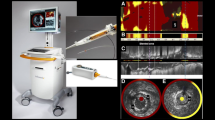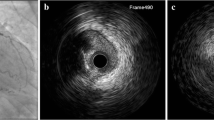Abstract
Purpose of Review
The purpose of this article is to review the basic principles of near-infrared spectroscopy (NIRS) and its contemporary role in intracoronary imaging.
Recent Findings
NIRS has been demonstrated to effectively detect culprit lesions in acute coronary syndromes (ACS) and to potentially identify vulnerable plaque. Lipid-rich plaques detected by NIRS are also associated with higher incidence of future adverse cardiac events. Plaques with high lipid content detected by NIRS have been shown to predict periprocedural myocardial infarction during percutaneous coronary intervention (PCI). The beneficial effects of high-intensity statin therapy in terms of plaque regression and plaque stabilization have also been demonstrated using NIRS.
Summary
NIRS is a valuable intracoronary imaging tool to assess lipid burden in atherosclerotic plaques and has been validated against histopathologic data. The commercially available dual-modality NIRS-intravascular ultrasound (IVUS) catheter further provides complementary data regarding lesion and vessel characteristics, thereby facilitating planning and optimization of PCI. Finally, the ability of NIRS to detect vulnerable plaque opens up potential new opportunities for risk stratification and intensification of secondary preventive measures.



Similar content being viewed by others
References
Papers of particular interest, published recently, have been highlighted as: • Of importance •• Of major importance
Choi KH, Song YB, Lee JM, Lee SY, Park TK, Yang JH, et al. Impact of intravascular ultrasound-guided percutaneous coronary intervention on long-term clinical outcomes in patients undergoing complex procedures. JACC Cardiovasc Interv. 2019;12(7):607–20. https://doi.org/10.1016/j.jcin.2019.01.227.
Zhang J, Gao X, Kan J, Ge Z, Han L, Lu S, et al. Intravascular ultrasound versus angiography-guided drug-eluting stent implantation: the ULTIMATE Trial. J Am Coll Cardiol. 2018;72(24):3126–37. https://doi.org/10.1016/j.jacc.2018.09.013.
Kini AS, Motoyama S, Vengrenyuk Y, Feig JE, Pena J, Baber U, et al. Multimodality intravascular imaging to predict periprocedural myocardial infarction during percutaneous coronary intervention. JACC Cardiovasc Interv. 2015;8(7):937–45. https://doi.org/10.1016/j.jcin.2015.03.016.
Gardner CM, Tan H, Hull EL, Lisauskas JB, Sum ST, Meese TM, et al. Detection of lipid core coronary plaques in autopsy specimens with a novel catheter-based near-infrared spectroscopy system. JACC Cardiovasc Imaging. 2008;1(5):638–48. https://doi.org/10.1016/j.jcmg.2008.06.001.
Bharadwaj AS, Vengrenyuk Y, Yoshimura T, Baber U, Hasan C, Narula J, et al. Multimodality intravascular imaging to evaluate sex differences in plaque morphology in stable CAD. JACC Cardiovasc Imaging. 2016;9(4):400–7. https://doi.org/10.1016/j.jcmg.2016.02.007.
Madder RD, Goldstein JA, Madden SP, Puri R, Wolski K, Hendricks M, et al. Detection by near-infrared spectroscopy of large lipid core plaques at culprit sites in patients with acute ST-segment elevation myocardial infarction. JACC Cardiovasc Interv. 2013;6(8):838–46. https://doi.org/10.1016/j.jcin.2013.04.012.
Madder RD, Husaini M, Davis AT, VanOosterhout S, Harnek J, Gotberg M, et al. Detection by near-infrared spectroscopy of large lipid cores at culprit sites in patients with non-ST-segment elevation myocardial infarction and unstable angina. Catheter Cardiovasc Interv. 2015;86(6):1014–21. https://doi.org/10.1002/ccd.25754.
Madder RD, Puri R, Muller JE, Harnek J, Gotberg M, VanOosterhout S, et al. Confirmation of the intracoronary near-infrared spectroscopy threshold of lipid-rich plaques that underlie ST-segment-elevation myocardial infarction. Arterioscler Thromb Vasc Biol. 2016;36(5):1010–5. https://doi.org/10.1161/ATVBAHA.115.306849.
Madder RD, Smith JL, Dixon SR, Goldstein JA. Composition of target lesions by near-infrared spectroscopy in patients with acute coronary syndrome versus stable angina. Circ Cardiovasc Interv. 2012;5(1):55–61. https://doi.org/10.1161/CIRCINTERVENTIONS.111.963934.
Stone GW, Maehara A, Muller JE, Rizik DG, Shunk KA, Ben-Yehuda O, et al. Plaque characterization to inform the prediction and prevention of periprocedural myocardial infarction during percutaneous coronary intervention: the CANARY trial (Coronary Assessment by Near-infrared of Atherosclerotic Rupture-prone Yellow). JACC Cardiovasc Interv. 2015;8(7):927–36. https://doi.org/10.1016/j.jcin.2015.01.032.
Goldstein JA, Maini B, Dixon SR, Brilakis ES, Grines CL, Rizik DG, et al. Detection of lipid-core plaques by intracoronary near-infrared spectroscopy identifies high risk of periprocedural myocardial infarction. Circ Cardiovasc Interv. 2011;4(5):429–37. https://doi.org/10.1161/CIRCINTERVENTIONS.111.963264.
Cardiology ACo. LRP: can NIRS imaging be used to identify patients and non-culprit arteries at high risk for future events? 2018. https://www.acc.org/latest-in-cardiology/articles/2018/09/19/16/55/mon-115pm-lrp-coronary-near-infrared-spectroscopy-imaging-tct-2018. Accessed April 7, 2019.
Kini AS, Baber U, Kovacic JC, Limaye A, Ali ZA, Sweeny J, et al. Changes in plaque lipid content after short-term intensive versus standard statin therapy: the YELLOW trial (reduction in yellow plaque by aggressive lipid-lowering therapy). J Am Coll Cardiol. 2013;62(1):21–9. https://doi.org/10.1016/j.jacc.2013.03.058.
Kini AS, Vengrenyuk Y, Shameer K, Maehara A, Purushothaman M, Yoshimura T, et al. Intracoronary imaging, cholesterol efflux, and transcriptomes after intensive statin treatment: the YELLOW II study. J Am Coll Cardiol. 2017;69(6):628–40. https://doi.org/10.1016/j.jacc.2016.10.029.
Schuurman AS, Vroegindewey M, Kardys I, Oemrawsingh RM, Cheng JM, de Boer S, et al. Near-infrared spectroscopy-derived lipid core burden index predicts adverse cardiovascular outcome in patients with coronary artery disease during long-term follow-up. Eur Heart J. 2018;39(4):295–302. https://doi.org/10.1093/eurheartj/ehx247.
Danek BA, Karatasakis A, Karacsonyi J, Alame A, Resendes E, Kalsaria P, et al. Long-term follow-up after near-infrared spectroscopy coronary imaging: insights from the lipid cORe plaque association with CLinical events (ORACLE-NIRS) registry. Cardiovasc Revasc Med. 2017;18(3):177–81. https://doi.org/10.1016/j.carrev.2016.12.006.
Roleder T, Kovacic JC, Ali Z, Sharma R, Cristea E, Moreno P, et al. Combined NIRS and IVUS imaging detects vulnerable plaque using a single catheter system: a head-to-head comparison with OCT. EuroIntervention. 2014;10(3):303–11. https://doi.org/10.4244/EIJV10I3A53.
Raghunathan D, Abdel-Karim AR, Papayannis AC, daSilva M, Jeroudi OM, Rangan BV, et al. Relation between the presence and extent of coronary lipid core plaques detected by near-infrared spectroscopy with postpercutaneous coronary intervention myocardial infarction. Am J Cardiol. 2011;107(11):1613–8. https://doi.org/10.1016/j.amjcard.2011.01.044.
Oemrawsingh RM, Cheng JM, Garcia-Garcia HM, van Geuns RJ, de Boer SP, Simsek C, et al. Near-infrared spectroscopy predicts cardiovascular outcome in patients with coronary artery disease. J Am Coll Cardiol. 2014;64(23):2510–8. https://doi.org/10.1016/j.jacc.2014.07.998.
•• Kilic ID, Caiazzo G, Fabris E, Serdoz R, Abou-Sherif S, Madden S, et al. Near-infrared spectroscopy-intravascular ultrasound: scientific basis and clinical applications. Eur Heart J Cardiovasc Imaging. 2015;16(12):1299–306. https://doi.org/10.1093/ehjci/jev208 Provides an in-depth overview of the technical aspects and clinical applications of NIRS.
Infraredx. Makoto™ Intravascular Imaging System and the Dualpro™ IVUS+NIRS catheter. 2019. https://www.infraredx.com/ - p3. Accessed April 6 2019.
Lansky AJ, Stone GW. Periprocedural myocardial infarction: prevalence, prognosis, and prevention. Circ Cardiovasc Interv. 2010;3(6):602–10. https://doi.org/10.1161/CIRCINTERVENTIONS.110.959080.
Jaffe R, Charron T, Puley G, Dick A, Strauss BH. Microvascular obstruction and the no-reflow phenomenon after percutaneous coronary intervention. Circulation. 2008;117(24):3152–6. https://doi.org/10.1161/CIRCULATIONAHA.107.742312.
Brilakis ES, Abdel-Karim AR, Papayannis AC, Michael TT, Rangan BV, Johnson JL, et al. Embolic protection device utilization during stenting of native coronary artery lesions with large lipid core plaques as detected by near-infrared spectroscopy. Catheter Cardiovasc Interv. 2012;80(7):1157–62. https://doi.org/10.1002/ccd.23507.
Dixon SR, Grines CL, Munir A, Madder RD, Safian RD, Hanzel GS, et al. Analysis of target lesion length before coronary artery stenting using angiography and near-infrared spectroscopy versus angiography alone. Am J Cardiol. 2012;109(1):60–6. https://doi.org/10.1016/j.amjcard.2011.07.068.
Hanson ID, Goldstein JA, Dixon SR, Stone GW. Comparison of coronary artery lesion length by NIRS-IVUS versus angiography alone. Coron Artery Dis. 2015;26(6):484–9. https://doi.org/10.1097/MCA.0000000000000263.
• Erlinge D. Near-infrared spectroscopy for intracoronary detection of lipid-rich plaques to understand atherosclerotic plaque biology in man and guide clinical therapy. J Intern Med. 2015;278(2):110–25. https://doi.org/10.1111/joim.12381 Provides a thorough description of the role of NIRS in defining the composition of atherosclerotic plaque and its role in guiding therapy.
Narula J, Nakano M, Virmani R, Kolodgie FD, Petersen R, Newcomb R, et al. Histopathologic characteristics of atherosclerotic coronary disease and implications of the findings for the invasive and noninvasive detection of vulnerable plaques. J Am Coll Cardiol. 2013;61(10):1041–51. https://doi.org/10.1016/j.jacc.2012.10.054.
van der Wal AC, Becker AE. Atherosclerotic plaque rupture—pathologic basis of plaque stability and instability. Cardiovasc Res. 1999;41(2):334–44.
Patel D, Hamamdzic D, Llano R, Patel D, Cheng L, Fenning RS, et al. Subsequent development of fibroatheromas with inflamed fibrous caps can be predicted by intracoronary near infrared spectroscopy. Arterioscler Thromb Vasc Biol. 2013;33(2):347–53. https://doi.org/10.1161/ATVBAHA.112.300710.
Author information
Authors and Affiliations
Corresponding author
Ethics declarations
Conflict of Interest
All authors have no conflict of interest to disclose.
Human and Animal Rights and Informed Consent
This article does not contain any studies with human or animal subjects performed by any of the authors.
Additional information
Publisher’s Note
Springer Nature remains neutral with regard to jurisdictional claims in published maps and institutional affiliations.
This article is part of the Topical Collection on Intravascular Imaging
Rights and permissions
About this article
Cite this article
Swamy, P.M., Mamas, M.A. & Bharadwaj, A.S. Role of Near-Infrared Spectroscopy (NIRS) in Intracoronary Imaging. Curr Cardiovasc Imaging Rep 12, 34 (2019). https://doi.org/10.1007/s12410-019-9510-8
Published:
DOI: https://doi.org/10.1007/s12410-019-9510-8




